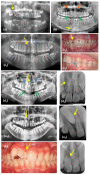Dental Anomalies' Characteristics
- PMID: 34202064
- PMCID: PMC8304734
- DOI: 10.3390/diagnostics11071161
Dental Anomalies' Characteristics
Abstract
The aim of this study was to characterize dental anomalies. The pretreatment records (photographs and radiographs) of 2897 patients (41.4% males and 58.6% females) were utilized to detect dental anomalies. The dental anomalies studied were related to number, size and shape, position, and eruption. A Chi-square test was carried out to detect associations between dental anomalies, jaw, and sex. A total of 1041 (36%) of the subjects manifested at least one dental anomaly. The prevalence of all dental anomalies was jaw-dependent and greater in the maxilla, except for submerged and transmigrated teeth. The most frequently missing teeth were the maxillary lateral incisor (62.3%) and the mandibular second premolars (60.6%). The most frequent supernumerary teeth were the incisors in the maxilla (97%) and the first premolars in the mandible (43%). Dental anomalies are more frequent in the maxilla and mainly involve the anterior teeth; in the mandible, however, it is the posterior teeth. These differences can be attributed to the evolutionary history of the jaws and their diverse development patterns.
Keywords: dental anomalies; dental diagnosis; growth and development; mandible; maxilla.
Conflict of interest statement
The authors declare no conflict of interest. The funders played no role in the design of the study; in the collection, analyses, or interpretation of data; in the writing of the manuscript; or in the decision to publish the results.
Figures



References
-
- Azzaldeen A., Watted N., Mai A., Borbély P., Abu-Hussein M. Tooth agenesis; Aetiological factors. J. Dent. Med. Sci. 2017;16:75–85. doi: 10.9790/0853-1601057585. - DOI
-
- Shilpa G., Gokhale N., Mallineni S.K., Nuvvula S. Prevalence of dental anomalies in deciduous dentition and its association with succedaneous dentition: A cross-sectional study of 4180 South Indian children. J. Indian Soc. Pedod. Prev. Dent. 2017;35:56–62. doi: 10.4103/0970-4388.199228. - DOI - PubMed
Grants and funding
LinkOut - more resources
Full Text Sources

